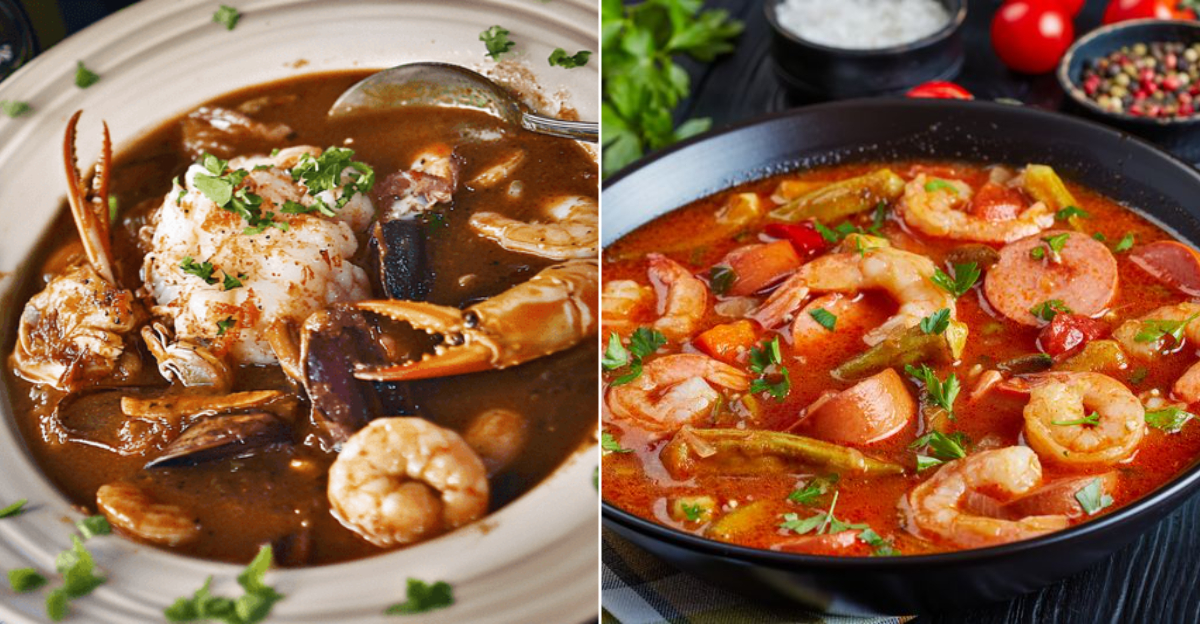9 Louisiana Gumbos That Tell The Story Of The State

Gumbo isn’t just Louisiana’s official state dish—it’s a living piece of history simmering low and slow in a single pot. Growing up in Baton Rouge, I quickly realized gumbo was more than comfort food; it was a story, a gathering, and a celebration of the state’s cultural roots.
Every family has its own treasured version, each recipe carrying whispers of the people who shaped Louisiana.
French settlers introduced rich roux, West African slaves contributed okra, Spanish traditions added spice, and Native Americans brought filé powder to the mix. With every spoonful, you’re not just eating—you’re tasting the Bayou State’s heritage.
1. Chicken and Andouille Gumbo
My grandmother’s chicken and andouille gumbo recipe has been passed down for five generations. The smoky andouille sausage – a gift from German immigrants who settled along the Mississippi – gives this gumbo its distinctive character.
Starting with a dark chocolate-colored roux (never rush this step!), this gumbo embodies patience and tradition. The trinity of bell peppers, onions, and celery creates the backbone of flavor that supports the tender chicken and spicy sausage.
Served over rice with a sprinkle of filé powder, this gumbo represents the everyday meal that brings Louisiana families together around the table, especially during those rare chilly evenings in the Deep South.
2. Seafood Gumbo
The Gulf Coast sings through every spoonful of seafood gumbo. Shrimp, crab, and oysters – whatever the day’s catch brings – transform a simple roux into an oceanic celebration.
French settlers along the coast adapted their bouillabaisse to local ingredients, creating this magnificent coastal treasure. The briny sweetness of fresh seafood needs no masking, just gentle companionship from okra and the holy trinity of Cajun cooking.
Watching my uncle carefully crack crab claws to add to his gumbo taught me that good food requires attention to detail. His secret? A splash of gumbo crabs (small crabs) added early to infuse the broth with their sweet essence before the delicate seafood joins the party.
3. Shrimp Gumbo
Sweet Gulf shrimp take center stage in this lighter gumbo variation that speaks to Louisiana’s bountiful waters. Unlike its seafood cousin, shrimp gumbo maintains laser focus on one star ingredient – letting those pink crescents shine without competition.
Fishermen returning to Bayou Lafourche would celebrate successful hauls with massive pots of this simpler gumbo. The delicate sweetness of fresh shrimp needs minimal accompaniment – just enough seasoning to complement without overwhelming.
My first cooking lesson came from Aunt Marie, who taught me to save shrimp shells to make stock. “That’s where all the flavor hides,” she’d say with a wink, stirring her pot of liquid gold that would become the foundation of her famous shrimp gumbo.
4. Duck and Sausage Gumbo
Hunting season in Louisiana brings this robust gumbo to tables across the state. Wild duck – often mallards or wood ducks from our abundant wetlands – creates a depth of flavor that store-bought chicken simply can’t match.
The marriage of wild game and smoky sausage tells the story of Louisiana’s hunting traditions. Sportsmen in the Sportsman’s Paradise return from blinds with these treasures destined for the gumbo pot.
Uncle Ray’s version features duck he hunts himself in the Atchafalaya Basin. The rich, almost liver-like quality of wild duck meat stands up beautifully to bold seasonings and long cooking times. His trick? Adding duck giblets to the roux for an extra layer of earthiness that makes this gumbo unforgettable.
5. Creole Gumbo
Tomatoes tell the tale in Creole gumbo – that vibrant red ingredient that distinguishes New Orleans-style preparations from their Cajun country cousins. Spanish influences brought tomatoes to the city’s cooking pots, creating this distinctive urban variation.
Creole gumbo reflects the sophisticated multicultural heritage of New Orleans itself. The addition of tomatoes creates a brighter, more acidic profile that balances the richness of the roux and showcases the city’s access to diverse ingredients through its bustling port.
My first taste came at Commander’s Palace, where the waiter explained that Creole cooking represents city cuisine while Cajun represents country cooking. That simple distinction opened my eyes to how geography shapes flavor even within a single state’s signature dish.
6. Okra Gumbo
West African culinary traditions shine through okra gumbo, named for its primary thickening agent rather than its protein. The word “gumbo” itself comes from the West African word for okra – “ki ngombo” – revealing the deep roots this vegetable has in Louisiana’s food history.
Enslaved Africans brought okra cultivation techniques to Louisiana plantations, forever changing the state’s culinary landscape. The vegetable’s natural thickening properties eliminated the need for flour-based roux in early versions of the dish.
Grandma Rose would slice the okra extra thin to minimize its sometimes polarizing texture while maximizing its thickening power. Her simple advice stays with me: “Fresh okra shouldn’t be slimy – that happens when it sits too long after cutting. Cook it right away!”
7. Gumbo Z’Herbes
Catholic traditions birthed this verdant variation that appears during Lent when meat restrictions called for creativity. The name – a Creole pronunciation of “gumbo aux herbes” (herb gumbo) – hints at its French colonial origins.
Legend claims the number of different greens used determines how many new friends you’ll make in the coming year. Collards, mustard greens, cabbage, spinach, and whatever else looks fresh at the market go into this healthful pot.
Sister Agnes at Holy Rosary School would prepare this for our class every Holy Thursday. She insisted that the odd number of greens (always at least seven) represented spiritual completeness. While the theology lesson escaped me then, the memory of that vibrant green bowl – surprisingly rich despite its meatless nature – remains a touchstone of Louisiana’s ability to transform necessity into culinary art.
8. Turkey and Sausage Gumbo
Thanksgiving leftovers transform into Louisiana gold through this practical gumbo variation. Turkey carcasses too precious to waste find new life in post-holiday pots across the state, creating a bridge between American and Cajun traditions.
The robust turkey flavor provides the perfect canvas for spicy sausage counterpoints. Unlike chicken gumbo, turkey’s stronger flavor profile stands up beautifully to bold seasonings without disappearing.
Black Friday in our house meant pajamas all day and turkey gumbo simmering on the stove. Mom would crack the leftover turkey bones with a hammer before adding them to the stock pot – “That’s where all the flavor hides,” she’d explain. By evening, the house would fill with an aroma even more enticing than Thanksgiving dinner itself.
9. Crawfish Gumbo
Spring in Louisiana announces itself not just with blooming magnolias but with crawfish gumbo appearing on dinner tables. Those tiny freshwater crustaceans – looking like miniature lobsters – create a gumbo that celebrates the state’s unique seasonal rhythms.
Crawfish season runs roughly from February through May, making this gumbo a special springtime treat. The sweet, distinct flavor of crawfish tails needs gentle handling – overcook them, and they’ll turn to rubber.
Every year, my family celebrates the first crawfish boil of the season by saving enough leftover tails for gumbo the next day. The heads and shells go into the stock pot first, creating a rich base that makes crawfish gumbo distinctly sunset-colored rather than brown. It’s Louisiana’s way of ensuring nothing goes to waste while creating something entirely new and magnificent.
